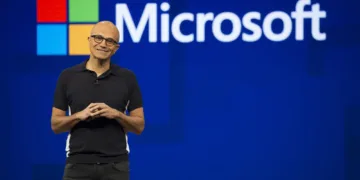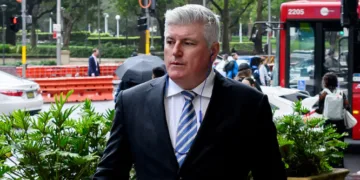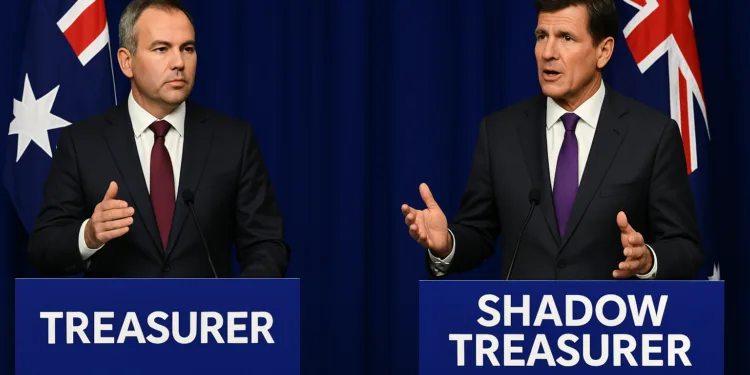Australia’s financial future took center stage during the highly anticipated Economic Policy Debate 2025 between Treasurer Jim Chalmers and Shadow Treasurer Angus Taylor. With a federal election just weeks away, the debate offered voters a stark contrast in economic visions from the country’s leading political factions: the Labor government and the Liberal-National Coalition.
Set against the backdrop of global trade tensions, volatile financial markets, and cost-of-living pressures, the Economic Policy Debate 2025 gave Australians a comprehensive look at how each party intends to navigate the economic headwinds ahead.
A Battle of Contrasts
The debate, hosted as part of the national election campaign, began with both treasurers outlining their fiscal philosophies. Treasurer Jim Chalmers emphasized the importance of government investment in renewables, digital infrastructure, and public services. He framed the Labor government’s approach as one focused on inclusive growth, climate responsibility, and long-term resilience.
Angus Taylor, representing the Coalition, struck a different tone. He centered his arguments on budget discipline, tax cuts for working families and small businesses, and restoring energy affordability. Taylor claimed that under Labor, government spending had ballooned while productivity growth stalled.
This economic clash wasn’t just ideological—it was deeply rooted in diverging plans that will shape Australia’s economic landscape in 2025 and beyond.
Taxation and Budget Management
Tax policy was one of the most hotly contested topics during the debate. Jim Chalmers defended the government’s decision to maintain stage three tax cuts while introducing targeted relief for low- and middle-income earners. He argued that fiscal support was essential amid rising inflation and global economic uncertainty.
Taylor countered that Labor’s “spending spree” would eventually require tax increases. He promised broader income tax relief and cuts to red tape for businesses, arguing this would unleash private sector growth and reduce the reliance on public spending.
Both sides also accused each other of mismanaging the national budget. Chalmers pointed to the Coalition’s record of deficits and underinvestment during their previous terms, while Taylor criticized Labor for lacking a clear pathway back to surplus.
Energy and Climate Spending
Energy policy sparked significant friction. Chalmers outlined Labor’s investments in renewable energy technologies, electric vehicle infrastructure, and decarbonization initiatives. He positioned these efforts as vital not only for climate goals but also for building future-proof industries and job creation.
Taylor was skeptical of Labor’s climate investments, claiming that these policies would drive up electricity costs and strain industry competitiveness. He advocated for a diversified energy mix including gas and cleaner coal technologies to ensure energy security and affordability.
In a country already grappling with fluctuating energy prices and severe weather events, this segment of the Economic Policy Debate 2025 was especially relevant to both urban and regional voters.
Technology, Innovation, and Jobs
The treasurers also touched on how emerging technologies and automation would impact employment. Chalmers emphasized Labor’s commitment to upskilling Australians through TAFE and university investments. He underscored the importance of digital inclusion and broadband access for regional communities.
Taylor criticized the Labor government for not doing enough to foster innovation-led growth in the private sector. He proposed stronger incentives for R&D, tech startups, and digital entrepreneurship, arguing that the future of work depends on empowering businesses to lead digital transformation.
From AI to green tech, both treasurers acknowledged that economic success in the coming decades hinges on how Australia manages the tech transition.
Cost of Living and Inflation
One of the most personal and immediate issues for voters was the cost of living. Chalmers noted that while inflation was easing, many Australians were still under pressure from mortgage rates, rent increases, and grocery bills. He highlighted targeted support measures, including electricity bill relief and increased childcare subsidies.
Taylor pushed back, saying Labor’s “excessive” government spending was exacerbating inflationary pressures. He pledged to reintroduce inflation control mechanisms through supply-side reforms and efficient governance.
For many families and small business owners watching the debate, this section struck a chord, as it directly addressed the financial strain being felt nationwide.
The Verdict
The Economic Policy Debate 2025 offered a comprehensive insight into two radically different economic playbooks. Labor, under Chalmers, promises long-term investment in public services and the green economy. The Coalition, led by Taylor, champions budget cuts, tax relief, and market-driven growth.
Both treasurers were praised for articulating their visions clearly, though independent analysts note that voters will ultimately decide whether they want a government that “spends to stimulate” or one that “cuts to stabilize.”
As the election campaign intensifies, this debate could prove to be a turning point—shaping not just fiscal policy but the future direction of Australia’s economy in an increasingly uncertain world.
Final Thoughts
The Economic Policy Debate 2025 isn’t just a headline—it’s a reflection of where Australia stands in a critical decade. For voters, investors, entrepreneurs, and workers alike, understanding the stakes and policies at play is crucial for navigating the road ahead.



























